| Pages:
1
..
38
39
40
41
42
..
68 |
Hennig Brand
International Hazard
    
Posts: 1284
Registered: 7-6-2009
Member Is Offline
Mood: No Mood
|
|
These devices have been extensively tested by different groups, guaranteed, but probably not much at the scale we are working at. Finding reporting of
these test results in the literature might be a challenge though.
"A risk-free world is a very dull world, one from which we are apt to learn little of consequence." -Geerat Vermeij
|
|
|
Laboratory of Liptakov
International Hazard
    
Posts: 1387
Registered: 2-9-2014
Location: Technion Haifa
Member Is Offline
Mood: old jew
|
|
lead
In one patent, unfortunately I do not know the source, is center of the liner filled with lead. This method can readily be formed thick and heavy
center. For better stability...LL
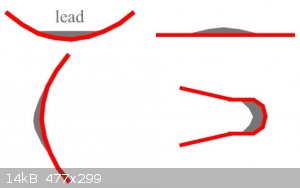
|
|
|
Fulmen
International Hazard
    
Posts: 1716
Registered: 24-9-2005
Member Is Offline
Mood: Bored
|
|
Interesting idea, however it will increase the complexity of the liner. I'd suggest making a smaller dimple that can be filled with lead and sanded
flat before inverting the liner.
|
|
|
Bert
Super Administrator
        
Posts: 2821
Registered: 12-3-2004
Member Is Offline
Mood: " I think we are all going to die. I think that love is an illusion. We are flawed, my darling".
|
|
Keeping the Lead bonded to the Copper layer under the forces applied might be an issue?
Two layers of Copper @ 1/2 the desired thickness, very slightly different in curvature near center, such that they could be clamped into proper
relationship, heated and a flux cored solder fed into the central void- Capilary action should take solder right to the outside edges, forming a solid
unit
Rapopart’s Rules for critical commentary:
1. Attempt to re-express your target’s position so clearly, vividly and fairly that your target says: “Thanks, I wish I’d thought of putting it
that way.”
2. List any points of agreement (especially if they are not matters of general or widespread agreement).
3. Mention anything you have learned from your target.
4. Only then are you permitted to say so much as a word of rebuttal or criticism.
Anatol Rapoport was a Russian-born American mathematical psychologist (1911-2007).
|
|
|
Fulmen
International Hazard
    
Posts: 1716
Registered: 24-9-2005
Member Is Offline
Mood: Bored
|
|
Shouldn't be a problem, lead solders well to copper and is extremely ductile. Use a good flux or pre-tin the copper and you should be safe.
But building a more complex geometry by soldering/brazing sheats of Cu would also be an option, I agree.
|
|
|
Laboratory of Liptakov
International Hazard
    
Posts: 1387
Registered: 2-9-2014
Location: Technion Haifa
Member Is Offline
Mood: old jew
|
|
center lead
Produce lead center is very laborious. Nevertheless, the result is not good. Liner is uneven, not regular. Precision production (with lead) requires
more precise instruments. Fulmen method is a good way to go. For further experiments (yet) will be used classic concave copper... ...LL ...LL
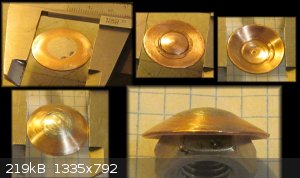
|
|
|
Laboratory of Liptakov
International Hazard
    
Posts: 1387
Registered: 2-9-2014
Location: Technion Haifa
Member Is Offline
Mood: old jew
|
|
There is a way for 20 minutes to produce a relatively precise cone for use SC...LL...
https://www.youtube.com/watch?v=s0vgSBIc2UY
|
|
|
Bert
Super Administrator
        
Posts: 2821
Registered: 12-3-2004
Member Is Offline
Mood: " I think we are all going to die. I think that love is an illusion. We are flawed, my darling".
|
|
That's a nice low tech metal forming process- The results look good.
Did you measure thickness of finished cone? Thickness tapers from near apex of cone to outer edge?
Rapopart’s Rules for critical commentary:
1. Attempt to re-express your target’s position so clearly, vividly and fairly that your target says: “Thanks, I wish I’d thought of putting it
that way.”
2. List any points of agreement (especially if they are not matters of general or widespread agreement).
3. Mention anything you have learned from your target.
4. Only then are you permitted to say so much as a word of rebuttal or criticism.
Anatol Rapoport was a Russian-born American mathematical psychologist (1911-2007).
|
|
|
Laboratory of Liptakov
International Hazard
    
Posts: 1387
Registered: 2-9-2014
Location: Technion Haifa
Member Is Offline
Mood: old jew
|
|
cone
The outer edges are thicker, thus no change, 1 mm thick. The top of the cone is copper certainly weaker, thinner. But the measurement is difficult.
Estimating peak cone is about 0.5mm thick... ...LL ...LL
|
|
|
Gargamel
Hazard to Others
  
Posts: 166
Registered: 9-3-2013
Member Is Offline
Mood: No Mood
|
|
Thank you for the good video LL.
One question:
How important is it to solder the cone in place?
Does it improve performance or does it just help to keep the come in position while pressing the charge in there?
|
|
|
Laboratory of Liptakov
International Hazard
    
Posts: 1387
Registered: 2-9-2014
Location: Technion Haifa
Member Is Offline
Mood: old jew
|
|
SC
First question: Performance is about the same. The second question, yes. Solder holds exactly the shape of the edge of the cone. This is important for
accurate beam Cu. Fill the charge is much easier. Energetic materials can be easily molded. This pressing operation is required short cone. It is
better to use plastic hard cover. As for EFP devices... ...LL ...LL

|
|
|
Laboratory of Liptakov
International Hazard
    
Posts: 1387
Registered: 2-9-2014
Location: Technion Haifa
Member Is Offline
Mood: old jew
|
|
SC 22
For the following experiment is used edge with the solder, from video. For home exam I think it's good. Of course, it's not professional equipment.
TeACP 15g @1,75.. ...LL ...LL
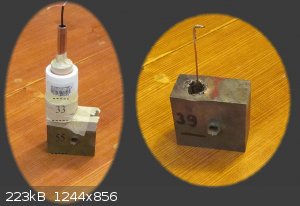
|
|
|
Bert
Super Administrator
        
Posts: 2821
Registered: 12-3-2004
Member Is Offline
Mood: " I think we are all going to die. I think that love is an illusion. We are flawed, my darling".
|
|
Dual liner shaped charge
A patent for same:
https://docs.google.com/viewer?url=patentimages.storage.goog...
I came across a set of these liners in "trumpet" configuration, outer Aluminum and inner Copper. Has anyone experimented with this configuration?
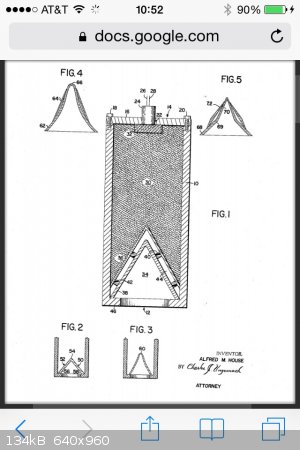
Rapopart’s Rules for critical commentary:
1. Attempt to re-express your target’s position so clearly, vividly and fairly that your target says: “Thanks, I wish I’d thought of putting it
that way.”
2. List any points of agreement (especially if they are not matters of general or widespread agreement).
3. Mention anything you have learned from your target.
4. Only then are you permitted to say so much as a word of rebuttal or criticism.
Anatol Rapoport was a Russian-born American mathematical psychologist (1911-2007).
|
|
|
NeonPulse
Hazard to Others
  
Posts: 417
Registered: 29-6-2013
Location: The other end of the internet.
Member Is Offline
Mood: Isolated from Reality! For Real this time....
|
|
Found something interesting today
While at work today i came across this little guy. since i work in the construction sector i have seen a few of these things laying around but never
took any notice. until today when i picked on up to look at it, and it looks like it would make a great little liner. it is copper, symmetrical and is
0.5mm thick all the way. it took me a little to figure out what it may be from and i think i found out. since i was near to an aircon unit being
installed where i picked it up i searched a bit about it and came up with this. its some sort of dust plug for the copper piping i think. i reckon a
test is in order to see if it work as i think it may. it fits nicely into some 20mm Cu tube but i may bend out the flange to get a little more area in
the dish and punch a point into the dead center.if so it may be possible to obtain more if you were to find airconditioner installation place and ask
if you could have a few. if i see them again i will be collecting them. NP
 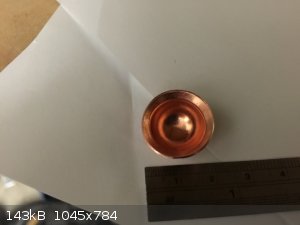 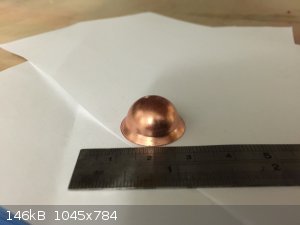
|
|
|
Hennig Brand
International Hazard
    
Posts: 1284
Registered: 7-6-2009
Member Is Offline
Mood: No Mood
|
|
1/2" Steel Cone and 4g of ETN Plastique Penetrates 3/4" (ca. 19mm) of Plate Steel
A test was just performed with one of the 1/2"W X 7/16""H (~53 degree apex angle) UK steel cones that Markx introduced earlier in this thread. The
steel plate was successfully penetrated, though a large carrot was left plugging the hole.
BTW, what I said back on page 38 of this thread, "I got a half order of the 1"W X 1"H (~53 degree apex angle) UK cones that Markx was using and the
other half in 1"W X 1/2"H (~90 degree apex angle) US style cone studs", was wrong, the steel cones are actually, ca. 1/2"W by 7/16"H and 1/2"W by
1/4"H.
Energetic Material Specifics
Charge:
4g of plastique; 80% ETN/10% polybutene/10% mineral oil
Initiation:
0.4g of PETN, 0.1g LA, pinch of basic lead picrate, cannon fuse
The steel cone was only held in place by the adhesive forces between it and the plastic explosive it was pressed into. A bit of scrap wood, with a
hole the diameter of the casing drilled into it, was used to provide the standoff (1.5CD).
Eighty grams of the recently made ETN (discussed in the NG thread) was used to make 100g of plastic explosive. The picture below shows 6.4g separated
from the 100g, but because it would not fit into the casing only 4g of it was actually used. A carrot was formed and was left jammed into the top 1/3
to 1/2 of the hole height. On examining the bottom of the 3/4" steel plate and the piece of firewood below, it was clear the jet passed completely
through however. A hole roughly 1/2" deep was blown into the piece of firewood below the steel target.
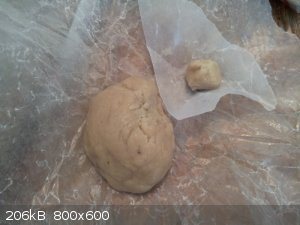 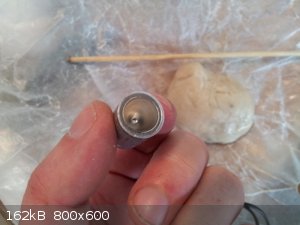 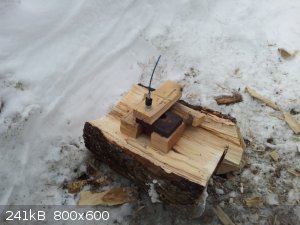
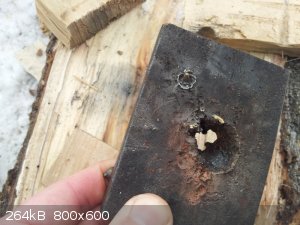 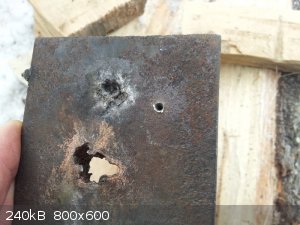 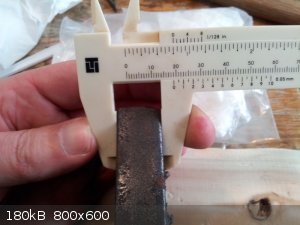
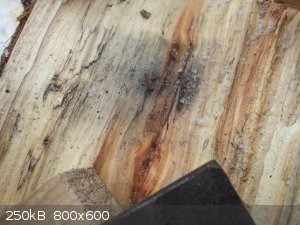 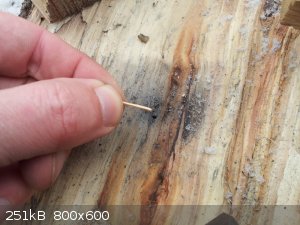
NeonPulse, those do look like they might make decent liners for EFPs.
[Edited on 17-3-2015 by Hennig Brand]
"A risk-free world is a very dull world, one from which we are apt to learn little of consequence." -Geerat Vermeij
|
|
|
Bert
Super Administrator
        
Posts: 2821
Registered: 12-3-2004
Member Is Offline
Mood: " I think we are all going to die. I think that love is an illusion. We are flawed, my darling".
|
|
Could you estimate the density of plastic?
We are looking at which of the smaller holes? There are several tests on this target, apparently.
[Edited on 17-3-2015 by Bert]
Rapopart’s Rules for critical commentary:
1. Attempt to re-express your target’s position so clearly, vividly and fairly that your target says: “Thanks, I wish I’d thought of putting it
that way.”
2. List any points of agreement (especially if they are not matters of general or widespread agreement).
3. Mention anything you have learned from your target.
4. Only then are you permitted to say so much as a word of rebuttal or criticism.
Anatol Rapoport was a Russian-born American mathematical psychologist (1911-2007).
|
|
|
Hennig Brand
International Hazard
    
Posts: 1284
Registered: 7-6-2009
Member Is Offline
Mood: No Mood
|
|
The density of this type of plastique was around 1.43g/cc the couple of time I measured it in the past, but it can vary a bit. I could maybe measure
some in a while and get back to you.
Ok, I just measured the density. The water displacement method was used to measure volume. A piece of the plastic explosive was carefully weighed,
then the sample was placed into a graduated cylinder which contained enough water that when the plastic explosive was added it was not too far from
full (graduated cylinders are more accurate the more close to being full they are in general).
Mass of Plastique: 11.35g
Volume before addition: 212.0mL
Volume after addition: 219.6mL
Volume of Plastique: 219.6mL - 212.0mL = 7.6mL
Density of plastique = 11.35g / 7.6mL = ca. 1.49 g/mL
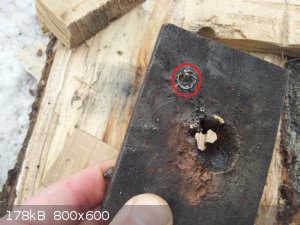 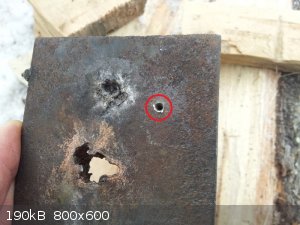
Found an interesting Doctoral thesis on shaped charge theory. In the near future I think I will have a closer look at it.
Attachment: Penetration of the Shaped Charge.pdf (4.3MB)
This file has been downloaded 962 times
Plastic Explosive Stability
I wonder if mineral oil helps stabilize the ETN the way that Vaseline stabilizes Cordite propellants.
[Edited on 17-3-2015 by Hennig Brand]
"A risk-free world is a very dull world, one from which we are apt to learn little of consequence." -Geerat Vermeij
|
|
|
Bert
Super Administrator
        
Posts: 2821
Registered: 12-3-2004
Member Is Offline
Mood: " I think we are all going to die. I think that love is an illusion. We are flawed, my darling".
|
|
Do you mean stabilize ETN against chemical degradation/deterioration, or stabilize as in render less susceptible to accidental detonation?
If you previously gave the composition of the plastic, perhaps you could provide a link to that- Certainly seems to have VOD & power suitable for
the use.
Rapopart’s Rules for critical commentary:
1. Attempt to re-express your target’s position so clearly, vividly and fairly that your target says: “Thanks, I wish I’d thought of putting it
that way.”
2. List any points of agreement (especially if they are not matters of general or widespread agreement).
3. Mention anything you have learned from your target.
4. Only then are you permitted to say so much as a word of rebuttal or criticism.
Anatol Rapoport was a Russian-born American mathematical psychologist (1911-2007).
|
|
|
Hennig Brand
International Hazard
    
Posts: 1284
Registered: 7-6-2009
Member Is Offline
Mood: No Mood
|
|
To act as a chemical stabilizer, making the explosive more storage stable. It does also desensitize the explosive to initiation a lot as well, but
that was not what I was commenting on. The following was taken from the Naval Propellants page which has a pdf made of it in the propellants thread,
"Mark I cordite consisted of 37% nitrocellulose (13.1% Nitrogen), 58% nitroglycerine and 5% petroleum jelly. This last ingredient had originally been
used as a lubricant during the manufacturing process, but it was found that it also acted as a stabilizer as its unsaturated hydrocarbons counteracted
the byproducts of the decomposition process."
I wonder if the Vaseline we buy at the drug store is the same as what they were using to make Cordite. Has it been purified and the unsaturated
hydrocarbons been removed for the most part?
I just recently added the plastic explosive composition in the above description.
[Edited on 17-3-2015 by Hennig Brand]
"A risk-free world is a very dull world, one from which we are apt to learn little of consequence." -Geerat Vermeij
|
|
|
Jimbo Jones
Hazard to Others
  
Posts: 102
Registered: 15-10-2009
Member Is Offline
Mood: No Mood
|
|
Can you give some details about your plastic explosive manufacturing process?
Do you make different fractions, or just use the recrystallized ETN? Rolling or kneading?
I’m just curios, because the PE above have very good properties for such a primitive binder.
|
|
|
Hennig Brand
International Hazard
    
Posts: 1284
Registered: 7-6-2009
Member Is Offline
Mood: No Mood
|
|
Hot water from the tap (ca. 50C) was used to make a warm water bath. The polybutene and mineral oil were added to a glass bowl and heated on the warm
water bath and mixed until warm, soft and of much lower viscosity than when cold. The fine crystalline ETN was then added to the softened polybutene
and mineral oil mixture and then mixed with a plastic spoon. The partially incorporated plastic explosive "dough" was then placed on a previously
warmed (ca. 30-40C) glass cutting board and repeatedly rolled out with a smooth glass bottle or glass or non-stick rolling pin of some kind. A rubber
spatula can be used to scrap the "dough" off of the glass cutting board and off of the rolling pin when repeatedly rolling out the "dough". The
material may also be placed in some waxed paper and kneaded by hand through the waxed paper, which I often do at the end of the kneading process.
"A risk-free world is a very dull world, one from which we are apt to learn little of consequence." -Geerat Vermeij
|
|
|
markx
National Hazard
   
Posts: 646
Registered: 7-8-2003
Location: Northern kingdom
Member Is Offline
Mood: Very Jolly
|
|
Nicely done! Although you might want to try a bigger standoff with these small cones....I found that 3-3,5CD gives the best result in terms of clean
penetration. With smaller standoffs I had a very similar picture with the carrot getting stuck in the target, but the jet passing cleanly through. I
guess with small charges and a 1,5CD standoff the cone has not enough time to fully form into a "spearhead", the edges hit the target on a wide area
and seem to break the impulse.
Exact science is a figment of imagination.......
|
|
|
Hennig Brand
International Hazard
    
Posts: 1284
Registered: 7-6-2009
Member Is Offline
Mood: No Mood
|
|
Thanks, yeah, I was thinking that too the more I looked at the images above. However, I only used 1.5CD for the last test, with a 3/8" steel target,
and there was a nice clean hole, but in that case the cone was anchored (sitting on a lip of aluminum left in the casing when it was bored out on the
lathe) and this time the cone was not anchored at all. I will increase the standoff, for the next test, which should help.
"A risk-free world is a very dull world, one from which we are apt to learn little of consequence." -Geerat Vermeij
|
|
|
markx
National Hazard
   
Posts: 646
Registered: 7-8-2003
Location: Northern kingdom
Member Is Offline
Mood: Very Jolly
|
|
Time for waveshapers 
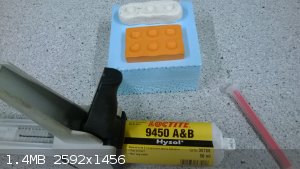 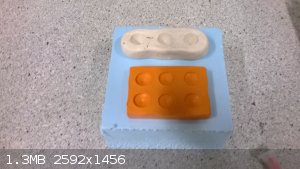 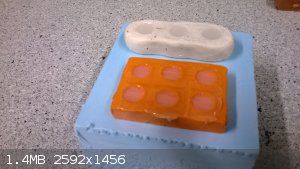 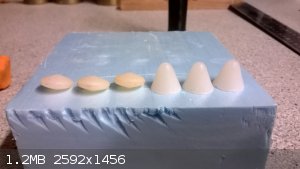 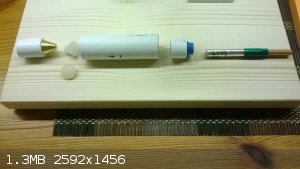 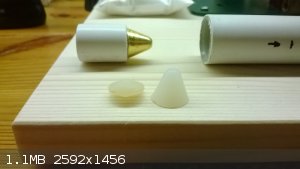 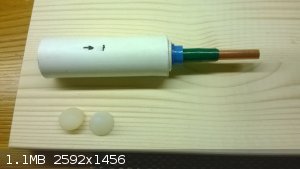 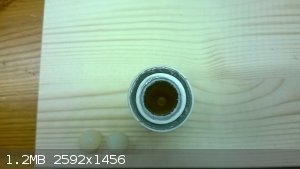
I think NitroGenes already tested some configuration of waveshapers with quite a success on this thread....I'll try to meet the challenge tomorrow

The power source ( PETN with 10% by mass 5/2 mix of polybutene and castor oil:
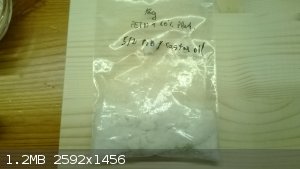
[Edited on 19-3-2015 by markx]
Exact science is a figment of imagination.......
|
|
|
Hennig Brand
International Hazard
    
Posts: 1284
Registered: 7-6-2009
Member Is Offline
Mood: No Mood
|
|
Looking forward to your test and to learn a little bit about wave shaping. Nice neat assembly.
"A risk-free world is a very dull world, one from which we are apt to learn little of consequence." -Geerat Vermeij
|
|
|
| Pages:
1
..
38
39
40
41
42
..
68 |